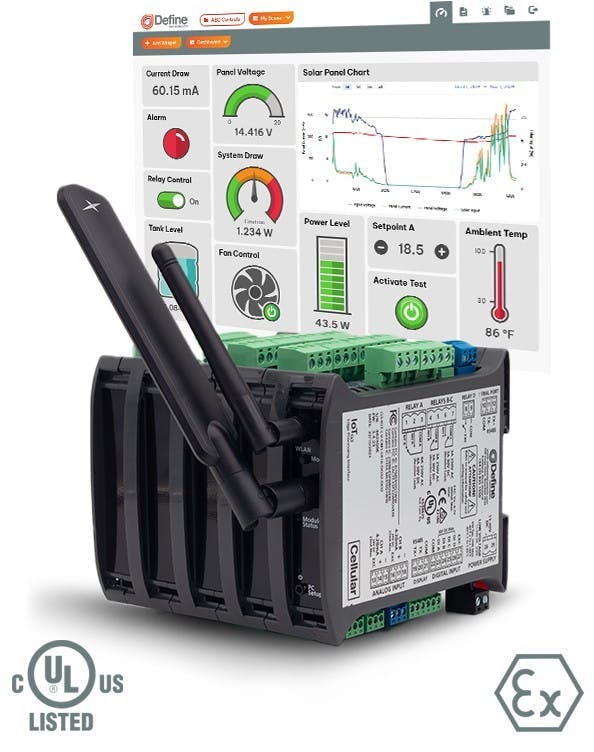Smart, intrinsically safe I/O systems bring IoT connectivity to hazardous and mobile environments
Key Highlights
- IoT-ready I/O systems can transmit data directly to the cloud using cellular networks, enabling remote monitoring and alerting
- Engineers can extend operating life through intelligent I/O module control, sensor cycling and configurable polling intervals.
As industrial applications continue to evolve, the need for adaptable, intelligent monitoring systems grows more urgent. This is especially true in areas involving volatile materials. Input/output (I/O) systems are becoming more versatile, safer and better integrated into Internet of Things (IoT) architectures. The convergence of mobility, intrinsic safety and cloud connectivity can meet the unique demands of hazardous environments.
Monitoring in a hazardous, mobile environment
Many applications have one top priority: monitoring environmental and equipment data at specific locations. However, often, there are three hurdles in situations like these that present themselves.
The first is the hazardous location requirements. Any area where a gas or other flammable substance is present must meet very tight safety standards. For example, a particular setup could be rated for Class I, Division 2 (or "zone") environments, meaning equipment in that area must be intrinsically safe or explosion-proof.
The second challenge that often presents itself is mobility. Unlike a traditional fixed installation, some systems are intended to be mobile, deployed temporarily in various field locations. It may operate independently on battery and solar power, without hardwired infrastructure. Finally, many setups require autonomous operation and data access. It may need to collect a range of I/O signals, perform on-device logic or calculations, and transmit data to the cloud for remote monitoring.
This combination of mobility, hazardous location requirements, and autonomous communication only emphasize the complexity of these kinds of systems.
I/O systems
In this type of setup, the monitoring system must track a variety of input types, including analog current signals, analog voltage measurements, discrete digital signals and temperature readings.
Many I/O systems are modular, and the I/O configuration can be customized by adding modules. In some cases, the individual analog inputs can be configured to meet the needs of each individual point.
From a safety perspective, all components, including the I/O itself and the power sources, must meet intrinsic safety standards. Otherwise, the equipment can’t operate within the designated zone without leading to ignition risks.
IoT-integrated I/O
Such a model breaks down in mobile or hazardous scenarios. Long cable runs, explosion-proof barriers and centralized control are not practical when dealing with field-deployed, battery-powered stations located in potentially explosive atmospheres.
Applications today can use an integrated, cloud-ready zone-rated I/O system with its own onboard logic and cellular communication. This approach eliminates the need for dedicated PLCs, external modems or network interfaces, wired connections leaving the hazardous zone, and intrinsic safety barriers crossing in and out of the zone.
Alternatively, the unit can act as a self-contained smart device. A built-in SIM card can scan for the strongest available cellular network and transmit data to a cloud environment where users can monitor values and receive alerts.
Get your subscription to Control's tri-weekly newsletter.
Power management
A key factor in making this kind of system viable is energy efficiency. Since these devices may need to be deployed in the field for 30-day stints with no permanent power connection, preserving battery life is critical. Engineers can optimize this by using onboard logic to control when I/O modules are powered. They can also cycle sensors on and off as needed to reduce energy draw, and allow configurable polling intervals to balance responsiveness with power conservation
This fine-tuned power control means the device can stay operational for the full duration of deployment without needing a recharge or manual maintenance.
Simplifying complex integrations
In a conventional setup, building a system as outlined above would require at least four or five different components: a field-capable I/O system, a PLC or controller, a communication device, zone barriers and safety-rated enclosures and power management hardware. Each piece would need to be individually sourced, integrated, programmed and maintained. This ultimately creates layers of complexity and opportunity for failure.
By contrast, systems can now combine those functionalities into one integrated unit, with I/O, logic, communications and safety ratings all bundled together, dramatically reducing the engineering burden and accelerating deployment.
The same kind of solution has been explored in the past using multiple standalone components, but it required significantly more effort and engineering overhead. The difference here was that the mobile I/O system has already done the integration work, allowing engineers to focus on the application rather than the infrastructure.
The approach outlined is broadly applicable across industries where safety, mobility and data access intersect. Some possible applications would include temporary fuel stations or chemical storage sites, mobile refueling or service vehicles, remote environmental monitoring in hazardous zones or off-grid industrial installations.
As more industrial systems move toward data-driven decision-making, the demand for easy-to-deploy, intrinsically safe and IoT-enabled devices will continue to grow.
The future of I/O
There is an important shift happening in industrial automation: I/O is no longer just passive hardware, but a smart, connected and mobile platform.
By marrying intrinsically safe data acquisition with IoT connectivity and power-aware design, modern I/O systems are enabling new levels of flexibility and safety in environments that were previously too difficult or dangerous to monitor effectively.
For engineers working in hazardous or mobile environments, this approach represents a path forward: less wiring, fewer components, faster deployment, and safer, smarter systems.
About the Author

Michael Ecklund
Valin Corporation
Michael Ecklund is a technical specialist at Valin Corporation, a subsidiary of Graybar, and a technical solutions provider for the technology, energy, life sciences, natural resources and transportation industries. To learn more about Valin’s solutions and capabilities, please visit www.valin.com, or to browse our product portfolio please visit www.valinonline.com.


